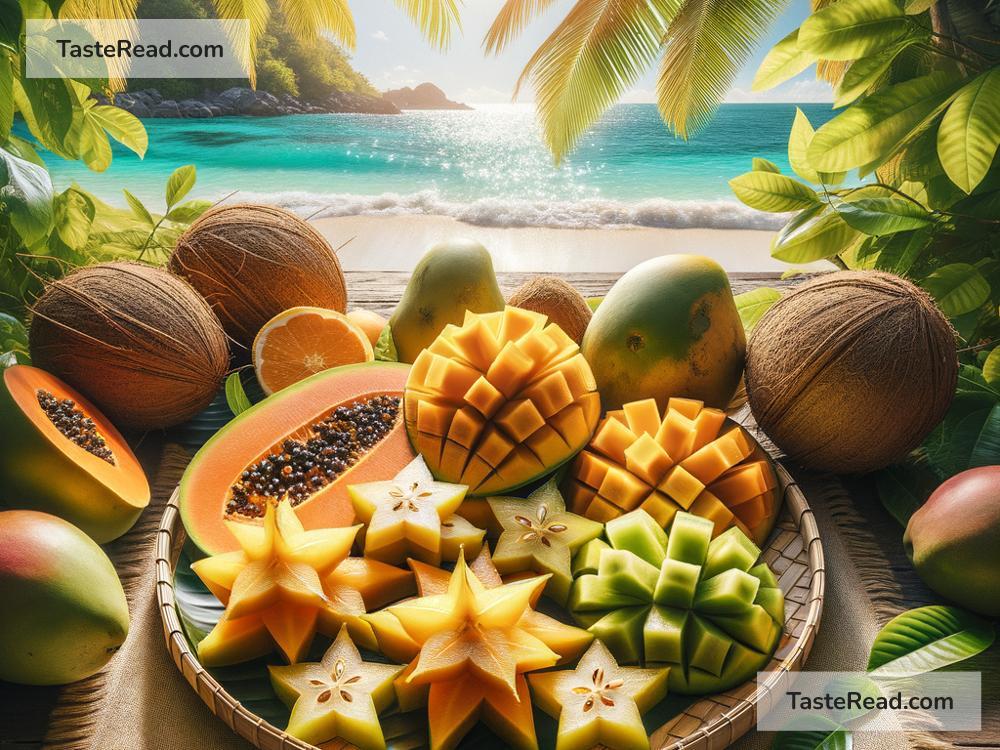The Curious Story of Starfruit in Tropical Cuisines
Tropical regions are famous for their delicious fruits, and one of the most fascinating among them is the starfruit. This bright yellow fruit, also called carambola, has a unique star-like shape when sliced, making it stand out. It’s not just beautiful to look at but also full of flavor and history. Starfruit has a special place in tropical cuisines around the world, and its journey across cultures is as captivating as its taste.
What Is Starfruit?
Starfruit grows on a small tree called Averrhoa carambola, which is native to Southeast Asia. Countries like Sri Lanka, Malaysia, and the Philippines were its original home, but now it’s grown in many tropical parts of the world, including South America, the Caribbean, and even southern Florida.
The fruit is yellow or green and shaped like an elongated oval with five or more ridges running down its sides. When you cut it into slices, each piece looks like a star — hence the name “starfruit.” Its skin is waxy and thin, and the flesh is juicy, with a flavor that’s often described as a mix between sweet and tangy, like a blend of apples, citrus, and grapes. There’s even a slightly sour variety of starfruit for those who enjoy more tanginess in their snacks!
How Starfruit Joined Tropical Cuisines
Starfruit has been a part of tropical cuisines for centuries, especially in Southeast Asia. It’s used in savory dishes, sweet snacks, salads, and even drinks. As trade and travel flourished, starfruit spread to other countries, and each region put its own spin on how it’s prepared and eaten.
In Southeast Asia, starfruit is often added to curries and stir-fries, where its tartness enhances the flavor of meats and fish. In countries like Thailand, Malaysia, and India, it’s sometimes paired with spices and chili for a bold contrast. In the Philippines, the fruit is called balimbing, and locals enjoy it raw, dipped in salt or sugar.
When starfruit arrived in South America, it began appearing in tropical desserts and drinks. For example, in Brazil, it’s blended into smoothies or made into jams and jellies. In the Caribbean islands, starfruit juice is a popular refreshment on hot days, often spiced with ginger to make it even more flavorful.
The Health Benefits of Starfruit
It’s not just the unique shape and flavor that make starfruit special; it’s also packed with nutrients. Starfruit is low in calories and high in vitamin C, making it a great choice for boosting immunity. It also contains fiber, which helps with digestion, and antioxidants that benefit overall health.
However, there’s a curious note of caution related to this fruit. Starfruit contains plant compounds that can be harmful to people with kidney problems. Doctors advise avoiding it if your kidneys aren’t healthy, as it can lead to complications. For most people, though, starfruit is a nutritious and safe fruit to enjoy.
Creative Ways to Eat Starfruit
One of the reasons starfruit is so popular in tropical cuisines is its versatility. You can eat it fresh right off the tree, slice it into a star-shaped garnish for salads, or turn it into juice, jams, or chutneys. In fact, starfruit is so beautiful that chefs love to use it as a decoration for cakes and cocktails.
Here are some popular ways to enjoy starfruit:
-
Raw and Sliced: Eat starfruit fresh after washing it. Its crisp, juicy texture makes it a perfect snack. Sprinkle some salt or chili powder on top for extra zing.
-
Starfruit Juice: Blend starfruit with water and a bit of sugar to make juice. Add mint leaves or ginger to create a refreshing tropical drink.
-
Tropical Curries: Starfruit chunks can add a tart flavor to coconut-based curries, balancing the richness of the dish.
-
Grilled Starfruit: Grill slices of starfruit to caramelize its sugars. This makes a sweet and smoky side dish for barbecues.
-
Desserts: Starfruit can be transformed into jams, jellies, or candied slices to brighten up desserts.
-
Cocktails: Starfruit slices work brilliantly as garnishes for tropical cocktails, adding a touch of elegance.
Starfruit Around the World
What’s truly curious about starfruit is how it has adapted to different cuisines globally. In Asia, it often has a savory role, while in Latin America and the Caribbean, it shines as a sweet treat or refreshing beverage. In countries like Australia and the United States, where starfruit is less common, it’s treated as an exotic tropical delicacy.
Chefs across the world love the fruit not only for its taste but for its eye-catching appearance. A simple plate of fruit can transform into a work of art when starfruit is added.
The Magic of Starfruit
Whether you grew up eating starfruit or have only recently discovered it, there’s no denying its charm. Its star-like shape, tangy-sweet taste, and versatility make it a magical addition to any dish. It’s a fruit that tells a story of merging cultures and flavors, connecting people across tropical regions and beyond.
Next time you see a starfruit at the market, give it a try. Slice it up to reveal its stars, take a bite, and taste the wonder of the tropics. Who knows? You may just find your next favorite fruit!


